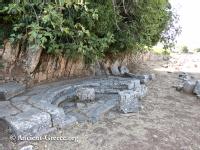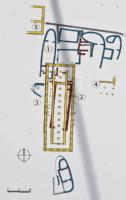Temple of Apollo, Thermon
Archaeological Development
The site of the Temple of Apollo was first identified in the late 19th Century by W. J. Woodhouse, subsequent excavations were then carried out by G. Sotiriades and K. A. Rhomaios in the early 20th century.
The temple was an archaizing rebuild of its predecessor, possibly burnt down during a sack by the Macedonians. After 206 B.C, the final temple of Apollo Thermios was built over the original temple. An inscription reused in the foundations of the south facing temple of Apollo dates the structure to the late 3rd century B.C. After the dispersal of the Aetolian League in 167 B.C. due to the Roman conquest of the territory, the sanctuary was abandoned. Graves dated to the 1st century B.C, discovered in the temenos area of the site, indicate that the sanctuary was no longer a sacred site by this time.
The site was a principle centre to the Aetolians and so of great historical interest as well as archaeological interest in the development of the first temples. The 5 by 15 Doric colonnade surrounding a long and narrow shrine, had ten panels of paintings found along the two sides of the temple, from 630/20 B.C, and was built on top of the preceding temple.
Other smaller sanctuaries on the site where identified as being dedicated to Apollo Lyseios and Artemis. Recent studies have called attention to the mid seventh century temple to the Cult of Artemis due to its large terracotta slabs depicting mythological scenes.
Gods/Heroes
The Chief god of the sanctuary is Apollo Thermios, a divinity of heat and a protector of flocks. The epithet comes from a connection to hot springs, although no thermal waters were found near the site.
This epithet can also be found in Olympia:
- Pausanias, Description of Greece. (V.15.7): “After re-entering the Altis by the processional gate there are behind the Heraeum altars of the river Claudeus and of Artemis; the one after them is Apollo’s, the fourth is of Artemis Coccoca, and the fifth is of Apollo Thermius. As to the Elean surname Thermius, the conjecture occurred to me that in the Attic dialect it would be Thermios (God of Laws).”
If this meaning behind the epithet is the same at the site in Thermon, this could be a link to the Aetolian assembly that took place there.
Archaeologist Rhomaios also linked this epithet to the Aetolian hero, Thermios, the brother of Oxylus, who was originally a local Aetolian god of the sun and fire. However, this link is speculative and merely a hypothesis.
Ritual Activity
Sacrifice: There is sacrificial evidence on this site as the temple was discovered to be built over a further structure named 'Megaron B', where layers of ashes from 900 - 700 B.C were found. Archaeologist K. Rhomaios demonstrated that these ashes were the result of sacrifices.
Dedications: As well as sacrificial ashes, small animal bones and vase fragments were found deposited round the pillars, which were suggested to be familiar to festivals held in western Greece for Artemis Laphria. Thus implying that these findings could be evidence of dedications on the site. Several semi-circular bases were found at the facade of the east Stoa, these bases are though to have held over 2000 statues.
Festivals: An Aetolian festival called the Thermika, took place at the same time as the Aetolian assembly and was connected with the Panhellenic games. This, along with the convenience of a set date, resulted in large numbers of citizens attending the festival.
Other: Athletic games were held annually. Plus, a statue base formed from a pile of shields was found on the site and was likely to commemorate the 279 BC Aetolian victory over the Gauls.
Other Activities
Besides being a religious hub, the temple was used by the Aetolian League, founded around 370 B.C, for a festival and fair each year during which their magistrates were elected. Thus making the temple of Apollo an important political site as well. Thermon benefited from the political power the League held in the 3rd century.
Strabo, Geography. (10. 3. 2.): “Therma in Aetolia (where it is the ancestral custom to hold their elections of magistrates)”
Polybius, The Histories. (4.37.2): “For the Aetolians hold their elections after the autumn equinox…”
A selection of Mycenaean pottery found at the site indicating that the Aetolians had a network of trade contacts.
Historical Significance
Thermon was the political and religious centre of the Aetolian community. This centre was formed by the Temple of Apollo. Thermon was a significant site in the late fifth and early fourth century B.C and this importance was accentuated by the annexation of Kalydon and Naupaktos by the Achaeans around 390 B.C, as Thermon became the focus of cultic interactions. The temple of Apollo was used as the central location of the Aetolian League with the function of strengthening the leagues unity by mean of common cult activity. The status of the site at Thermon continued unchallenged even when both the temple of Apollo in Delphi and Sanctuary of Artemis in Kalydon came under Aetolian control in the fourth and third centuries B.C.
Who used the site, and where did they come from?
Thermon as a Town: During the Hellenistc period, the temple site held presige and was the focus of considerable settlements.
- Polybius described it as the "natural citadel of all Aetolia."[1] By the third century B.C., the sanctuary had became a town, surrounded by fortifications to protect its wealth. Polybius further described the houses of Thermon as "more richly furnished than than any in Aetolia."[2]
Select Site Bibliography
Primary Sources:
Pausanius, Description of Greece, trans, W. H. S. Jones. (Harvard University Press: 1918)
Polybius, The Histories, trans. W. R. Paton. (Harvard University Press: 1927)
Strabo, Geography, trans. H. L. Jones (Harvard University Press:1932)
Secondary Reading:
Cook, R. M, The Archetypal Doric Temple, in 'Annual of the British School of Athens,' vol. 65. Ed. j. Bennet & P. Liddel. (Cambridge University Press: British School at Athens: 2013)
(Source: https://doi.org/10.1017/S0068245400014659)
Croon, J. H, Artemis Thermia and Apollo Thermios, in 'Mnemosyne', Vol. 9. (Brill: 1956)
(Source: http://www.jstor.org/stable/4427855)
Mackil, E., Creating a Common Polity: Relgion, Economy, and the Politics in the Making of the Greek Koinon. (University of California Press: Berkeley: Los Angeles: London: 2013)
Mackil, E, The Greek Koinon, in 'The Oxford Handbook of the State in the Ancient Near East and Meiterranean,' ed. P. F. Bang & W. Scheidel. (Oxford University Press: Feb 2013)
(Source: 10.1093/oxfordhb/9780195188318.013.0012)
Malacrino, C. G., Constructing the Ancient World: Architectual Techniques of the Greeks and Romans, trans. Jay Hyams. (Paul Getty Museum: Los Angeles: 2010)
Mee,C, & Spawforth, A, Greece: An Oxford Archaeology Guide. (Oxford University Press: 2001)
Spawnforth, T, The Complete Greek Temples. (Thames & Hudson Ltd.: 2006)
Footnotes
[1] - Polybius, Histories. (V.8.4)
[2] - Polybius, Histories. (V.8.6)
[3] - North-East Corner of the Temple: http://ancient-greece.org/archaeology/thermos.html
[4] - East Stoa Facade: http://ancient-greece.org/archaeology/thermos.html
[5] - Site Plan: http://ancient-greece.org/archaeology/thermos.html
Location
The site of the Temple of Apollo, Thermon, can be found in the Aetolian countryside, a mountainous region of Greece. The site acted as the main centre of the Aetolian people and state. It was at its height in the third century BC, when the Aetolians headed a powerful central Greek federation.
Site Plan

The Temple of Apollo Thermios north-east corner. [3]
Semi-circular bases that line the facade of the east Stoa. [4]
Site Plan. [5]
1. Megaron A
2. Megaron B
3. Temple of Apollo Thermios
4. Temple of Apollo Lyseios
5. Temple of Artemis
Colour key:
Blue: 16th - 123th c. BCE
Red: 11th - 9th c. BCE
Yellow: 7th - 6th c. BCE


